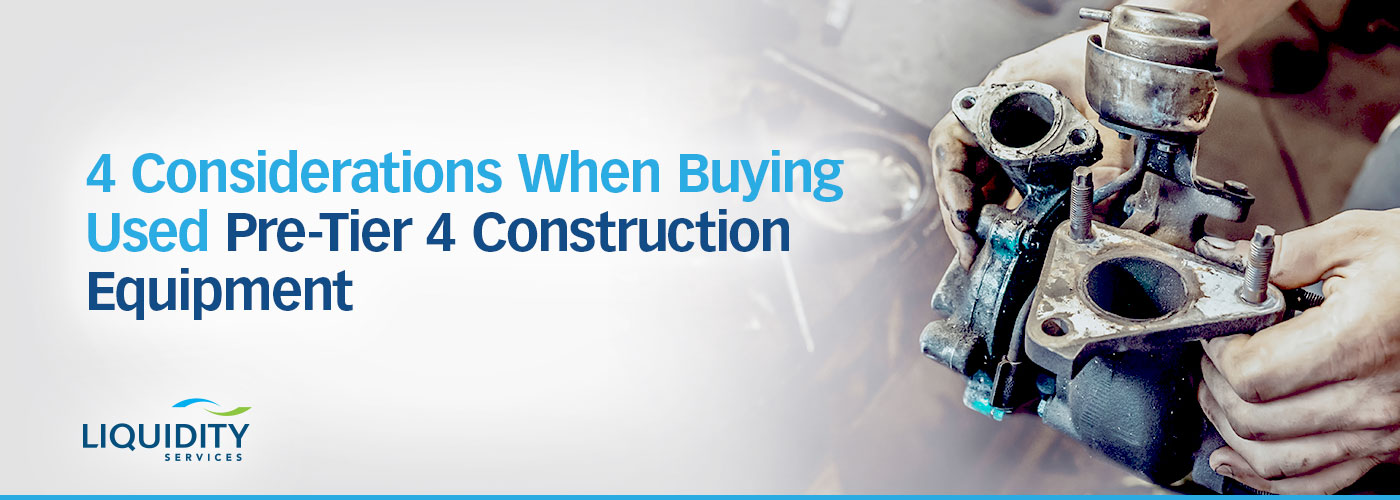
In the years since the EPA’s “Tier 4” emission standards first hit the heavy equipment world, a secondary market in older “pre-Tier 4” used construction equipment has blossomed. Buying pre-Tier 4 heavy equipment can be an economical way to address your business’s current needs. But, there are trade-offs and other factors to consider when you buy pre-owned heavy equipment – particularly when it comes to pre-Tier 4 machinery.
What are the EPA’s “Tier 4” emission standards for diesel equipment?
Basically, the Clean Air Act required the U.S. Environmental Protection Agency (EPA) to put regulations in place that would reduce air pollutants. In this case, “pollutants” would be black exhaust and soot from nonroad construction equipment’s diesel engines.
“Tier 4” is the grade of the EPA’s new emissions standards that all newly heavy equipment diesel engines must meet . From agriculture to construction to mining, new equipment must control its emissions through new technology.
Of course, meeting this new regulation can be expensive for heavy equipment manufacturers. The Independent Equipment Dealers Association estimates that new construction equipment costs buyers up to an additional 20% premium over models following less strict standards.
This expense explains the rise of pre-Tier 4 construction equipment in the secondary markets for business owners large and small.
What makes a piece of used construction equipment “pre-Tier 4”?
Essentially, “pre-Tier 4” heavy equipment were manufactured before the EPA’s mandate required all new equipment to meet the Tier 4 regulations. The EPA doesn’t require every currently operating piece of equipment to meet the new standards. Older equipment is “grandfathered” into the current ecosystem.
Depending on the equipment’s horsepower, Tier 4 regulations hit commercial heavy equipment manufacturers in 2014 and 2015. So, when evaluating a piece of used heavy equipment, look at its manufacturing date.
For example, if a used backhoe’s manufacturing year was 2013, it’s probably “pre-Tier 4” equipment. Consequently, the 2013 backhoe should be less expensive than a similar condition 2016 model.
4 Questions to Answer When Buying Used Pre-Tier 4 Construction Equipment
So, you’ve found a piece of heavy equipment that was made before the Tier 4 emissions regulations. Before you make an offer, find the answers to these four questions:
- Does the machinery meet its manufacturing year’s emissions standards? While current regulations grandfather in pre-Tier 4 heavy equipment, the EPA requires the machine to function at the emissions standard set when it was first made.
- Does the equipment have a solid maintenance record? You’re more likely to meet the required emissions standards with a well-maintained piece of equipment.
- Do you own a large “fleet” of diesel-engine equipment? Owners of many diesel-engine machines can only keep the same or fewer amount of pre-Tier 4 engines that they started with. Essentially, you can only replace a pre-Tier 4 engine if you retire another pre-Tier 4 machinery. The goal is for all owners to gradually start replacing their older equipment with ones that meet the newer standards.
- Do you bid on a lot of government work? Some states and contracts require that bidding contractors and businesses keep their emissions low during construction. This requirement will impact the type of engines you can use on-site, possibly limiting your ability to use pre-Tier 4 heavy equipment.
So whether you’re an independent business owner with a piece of heavy equipment you’d like to upgrade, or an international corporation looking to track and demobilize site assets after project completion, understanding the secondary market for pre-Tier 4 heavy equipment can radically impact your bottom line.
And, if you need help either selling, buying, or managing heavy equipment, Liquidity Services can lend a hand.



Comments are closed.